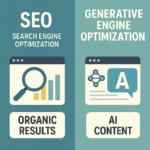Immersive Marketing: Using AR and VR to Engage Customers
In an increasingly digital world, brands face the ongoing challenge of creating memorable, engaging experiences that cut through the noise and forge meaningful connections with customers. Augmented Reality (AR) and Virtual Reality (VR) technologies have emerged as powerful tools in the modern marketer’s arsenal, offering unprecedented opportunities to create immersive experiences that captivate audiences and drive business results.
This article explores how forward-thinking brands are leveraging AR and VR to transform their marketing strategies, with practical insights on implementation, measurement, and future trends.
The Evolution of Immersive Marketing
Immersive technologies have evolved dramatically over the past decade. What began as novelty experiences with limited practical applications have matured into sophisticated marketing tools with measurable business impact.
Augmented Reality (AR) overlays digital content onto the real world, enhancing what users see with computer-generated information. Virtual Reality (VR) creates fully immersive digital environments that transport users to entirely new spaces. Both technologies have found their place in the marketing landscape, each with distinct advantages for different marketing objectives.
Recent advances in hardware accessibility, processing power, and content creation tools have dramatically lowered the barriers to entry for brands looking to implement immersive marketing strategies. What once required specialized equipment and substantial technical expertise can now be delivered through everyday smartphones and increasingly affordable headsets.
Strategic Applications of AR in Marketing
Augmented Reality has proven particularly effective for enhancing the customer journey at key decision points. Here are some of the most impactful applications:
- Virtual Try-Before-You-Buy Experiences
AR try-on experiences have revolutionized shopping across multiple categories:
- Fashion and Accessories: Brands like Warby Parker and ASOS use AR to let customers virtually try on glasses, clothing, and accessories, reducing return rates by up to 30% and increasing conversion rates by 40% in some cases.
- Beauty and Cosmetics: L’Oréal’s Virtual Try-On feature allows customers to test different makeup products in real-time, leading to a 2.5x increase in conversion rates compared to non-AR product pages.
- Home Furnishings: IKEA’s AR app lets customers visualize furniture in their actual living spaces, addressing a key purchase barrier and reducing returns by 35%.
These applications solve real customer pain points by reducing purchase uncertainty and helping customers make more confident buying decisions.
- Interactive Packaging and Products
AR-enhanced packaging transforms static products into interactive experiences:
- Storytelling: Wine brand 19 Crimes brings its labels to life with AR, allowing customers to hear the stories of the historical figures featured on each bottle, increasing engagement and driving a 35% sales increase.
- Product Information: Nestlé uses AR to provide nutritional information, recipes, and sustainability details through interactive packaging, enhancing the value proposition beyond the physical product.
- Entertainment: LEGO’s AR-enabled sets combine physical building with digital play experiences, extending engagement time and strengthening brand affinity.
These applications add value to physical products, creating differentiation in competitive markets and generating social sharing opportunities.
- Location-Based AR Experiences
Geolocation-triggered AR experiences connect digital content to physical locations:
- Retail Navigation**: Walmart’s AR in-store navigation helps customers locate products efficiently while delivering personalized promotions based on shopping history and location.
- Tourism Enhancement**: The city of Amsterdam’s AR app overlays historical information and interactive content at key landmarks, increasing tourist engagement and visit duration.
- Event Activation**: Coachella’s AR features enhance the festival experience with interactive art installations and practical information, driving social sharing and sponsor engagement.
These applications bridge the physical-digital divide, enhancing real-world experiences with contextually relevant digital content.
Strategic Applications of VR in Marketing
While AR enhances the real world, VR creates entirely new environments, offering different strategic advantages:
- Immersive Brand Storytelling
VR enables brands to tell stories with unprecedented immersion and emotional impact:
- Brand Heritage**: Hennessy’s VR experience takes customers on a journey through their cognac production process, from vineyard to distillery, creating deeper appreciation for the craft behind the product.
- Social Impact**: Toms Shoes uses VR to transport customers to communities where their one-for-one donations make an impact, strengthening emotional connection to their mission.
- Product Development**: Audi’s VR experience showcases the engineering and design process behind their vehicles, building perceived value and brand prestige.
These applications create emotional connections that traditional media cannot match, with studies showing 70% higher emotional engagement in VR compared to 2D viewing of the same content.
- Virtual Showrooms and Experiences
VR creates accessible experiences that would be impractical or impossible in the physical world:
- Real Estate: Sotheby’s International Realty offers VR property tours that allow potential buyers to explore homes remotely, reducing the sales cycle by 30% for participating properties.
- Automotive: BMW’s virtual showroom lets customers configure and experience vehicles without visiting a dealership, increasing configuration-to-purchase conversion by 25%.
- Travel: Marriott’s “VRoom Service” allows guests to virtually experience destinations before booking travel, driving a 17% increase in excursion bookings.
These applications overcome physical limitations, making experiences more accessible while reducing costs associated with physical infrastructure.
- Training and Educational Experiences
VR creates safe, controlled environments for learning and skill development:
- Product Training: Home Depot’s VR training program teaches customers how to complete home improvement projects, building confidence and driving related product sales.
- Safety Education: Insurance company AXA’s VR experience simulates household accidents to educate about prevention, positioning the brand as a proactive partner in safety.
- Professional Development: Walmart uses VR to train employees for Black Friday crowds, reducing anxiety and improving performance during high-stress retail events.
These applications position brands as educational partners while addressing practical barriers to product adoption or use.
Implementation Strategies for Immersive Marketing
Successfully implementing AR and VR marketing requires strategic planning and execution:
- Start with Clear Objectives
Effective immersive marketing begins with clearly defined business objectives rather than technology-driven initiatives. Identify specific marketing challenges or opportunities where immersive technologies can deliver measurable value:
- Reducing purchase uncertainty
- Increasing product understanding
- Creating emotional brand connections
- Generating social sharing and earned media
- Enhancing in-store or event experiences
Establish clear KPIs aligned with these objectives before beginning development.
- Choose the Right Technology for Your Goals
Select the appropriate immersive technology based on your specific objectives:
- AR is typically better for: In-context product visualization, enhancing physical products or locations, widespread accessibility via smartphones, and lower-barrier engagement.
- VR is typically better for: Complete immersion, emotional storytelling, complex product demonstrations, and creating experiences impossible in the physical world.
Consider your audience’s technology access and comfort level when making this decision.
- Focus on User Experience
The novelty of immersive technology quickly fades if the experience doesn’t provide genuine value. Prioritize user experience by:
- Addressing real customer needs or pain points
- Ensuring intuitive, frictionless interactions
- Optimizing performance for smooth experiences
- Providing clear instructions for new users
- Testing extensively with representative users
Remember that a simple, well-executed experience is better than a complex one with technical issues.
- Integrate with Broader Marketing Strategy
Immersive experiences should be integrated with your broader marketing ecosystem rather than standalone initiatives:
- Connect experiences to your CRM to capture valuable customer data
- Incorporate clear calls-to-action that advance the customer journey
- Promote immersive experiences across other marketing channels
- Use insights gained from immersive interactions to inform other marketing efforts
- Ensure consistent messaging and branding across all touchpoints
This integration ensures immersive marketing drives broader business objectives rather than existing in isolation.
- Measure and Optimize
Develop comprehensive measurement frameworks that capture both engagement metrics and business outcomes:
- Engagement Metrics: Time spent, feature usage, completion rates, return visits
- Attitudinal Metrics: Brand perception shifts, purchase intent, emotional response
- Business Outcomes: Conversion rate impact, average order value changes, return rate reduction
Use these insights to continuously optimize experiences and demonstrate ROI.
Future Trends in Immersive Marketing
As immersive technologies continue to evolve, several emerging trends will shape their application in marketing:
- AI-Enhanced Immersive Experiences
The integration of artificial intelligence with AR and VR is creating more personalized, adaptive experiences. AI can analyze user behavior within immersive environments to customize content in real-time, predict user needs, and create more natural interactions through voice and gesture recognition.
- Social and Shared Experiences
Immersive technologies are becoming increasingly social, allowing multiple users to share experiences simultaneously. Brands are creating collaborative VR spaces for product demonstrations, virtual events, and social shopping experiences that combine the immersion of virtual environments with the influence of social interaction.
- Persistent AR Layers
The development of AR cloud technology is enabling persistent AR content that remains in place across sessions and users. This allows brands to create lasting AR experiences tied to physical locations or products, building ongoing engagement rather than one-time interactions.
- Haptic Feedback and Multisensory Experiences
Advances in haptic technology are adding tactile feedback to immersive experiences, creating more convincing and engaging interactions. Combined with spatial audio and even scent technology, these multisensory experiences create deeper immersion and stronger emotional responses.
- Immersive Commerce
The lines between immersive experiences and e-commerce are blurring, with seamless purchasing capabilities being integrated into AR and VR environments. This creates frictionless paths to purchase within immersive brand experiences, turning engagement directly into conversion.
Conclusion: The Future of Customer Engagement
AR and VR represent a fundamental shift in how brands can engage with customers, moving from passive content consumption to active, immersive participation. These technologies create experiences that are not just seen or heard, but felt—generating stronger emotional connections and more memorable brand interactions.
As hardware becomes more accessible, content creation more streamlined, and consumer adoption more widespread, immersive marketing will transition from innovative differentiation to expected customer experience. Brands that develop expertise in these technologies now will be well-positioned to lead in this immersive future.
The most successful implementations will be those that move beyond novelty to deliver genuine value—helping customers make better decisions, learn new skills, connect with brands on a deeper level, or simply experience products and services in more meaningful ways.
To learn more about implementing AR and VR in your marketing strategy, explore our AR/VR Marketing Solutions or contact our team for a personalized consultation.





